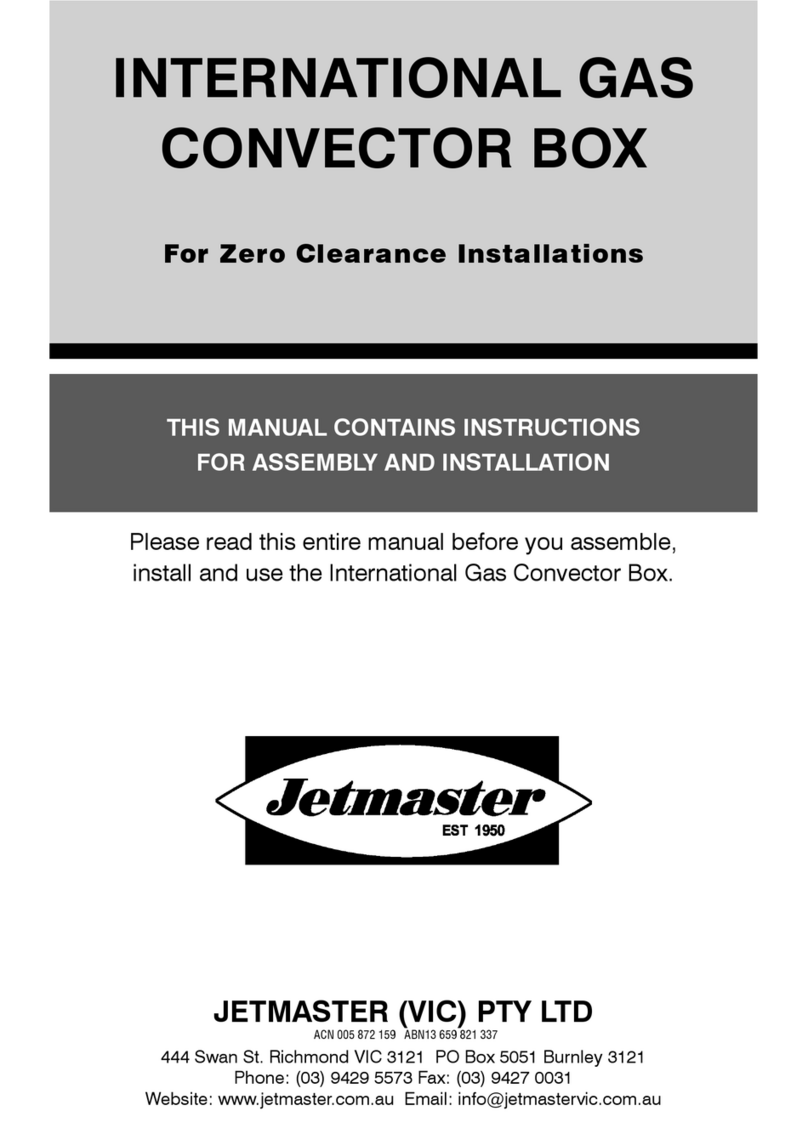9. Gas Cylinder, Pipe Runs and
Sizes
(This work must only be carried out by a
person who is a registered LPGAS Association
installer.)
1 Jetmaster LP Gas Convectors must
be operated off one or more 48 kg
cylinders, depending on size of unit.
The cylinder(s) must be positioned
outside, as close as possible to the
appliance, and in any case not further
than 30 metres, the cylinders must be
away from heat sources, electrical
devices, drains, windows and
combustible materials, in accordance
with SABS 087 Part 1: March 1999.
Cylinders must always stand in the
VERTICAL position and must be fixed
so they cannot fall or be knocked
over. For best performance, avoid cold
areas and shade.Where the regulator
or pipework is in a position which is
liable to be very cold in winter, it is
advisable to lag them to prevent
freezing up. It is always advisable to
fix the regulator vertically rather than
horizontally. This will prevent any
condensation settling in the bottom
of the regulator which will freeze up
in the cold weather causing the Gas
Convector to shut down.
2 Check the Jetmaster Pipe Sizing Chart
below to choose the correct size of
pipe for the Gas Convector size and
length of run. Although Jetmaster
supplies 4 metres of 8 mm copper
tube with LP Gas Convectors, it is
not necessarily of sufficient size if
larger fire or longer than 4 metre run
are to be fitted. Be sure to fit the right
size pipe. Do not run more than one
gas fire off each supply, without first
checking the fitter’s supply chart.Any
queries please contact Jetmaster
Technical Department.
LP pipe size: From cylinder and
low pressure regulator (28
Mbar) to gas appliance:
Copper tubing 8mm 15mm
LP Gas up to to 30 m
Convector 4 m
It is recommended by the LPGAS
Association that any pipe run greater
than 9 metres is supplied under high
pressure and a low pressure regulator
is fitted within 4 metres of the fire.
3 Having positioned the 48 kg gas
cylinder in a fixed position, connect
the regulator supplied to the flexible
hose, and the male hose connector
to the end of the copper tubing using
the compression fitting.These fittings
are supplied and should be used. If a
larger pipe is to be used then the
correct size of fittings will have to
be obtained.
4 Tighten the hose clamps and connect
the regulator to the cylinder. The
regulator should be protected from
rain and fixed in the vertical position
if possible alternatively angle the
regulator so that liquids cannot collect
on the top causing rusting of internal
components and subsequent
malfunctioning, i.e. the plastic cap
should not face upwards.The air vent
in the regulator must be pointing
downwards.
5 Cover the end of the gas pipe to
prevent dirt getting into it and
damaging the valve, which will
invalidate the Warranty.
INSTALLATION & OPERATING INSTRUCTIONS 7




























